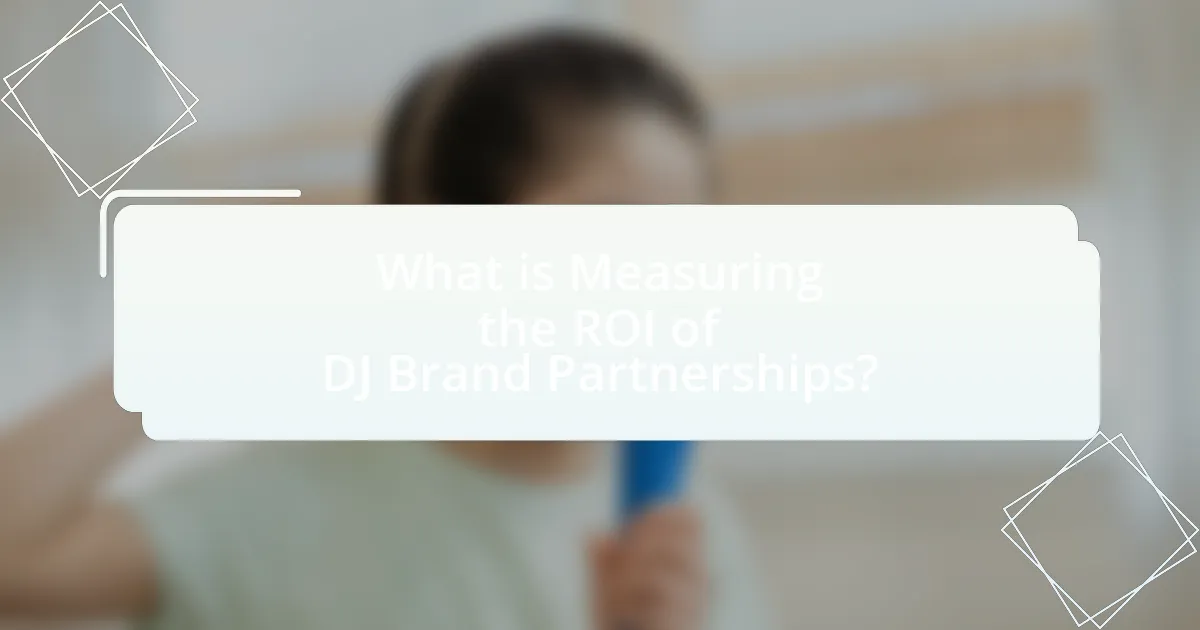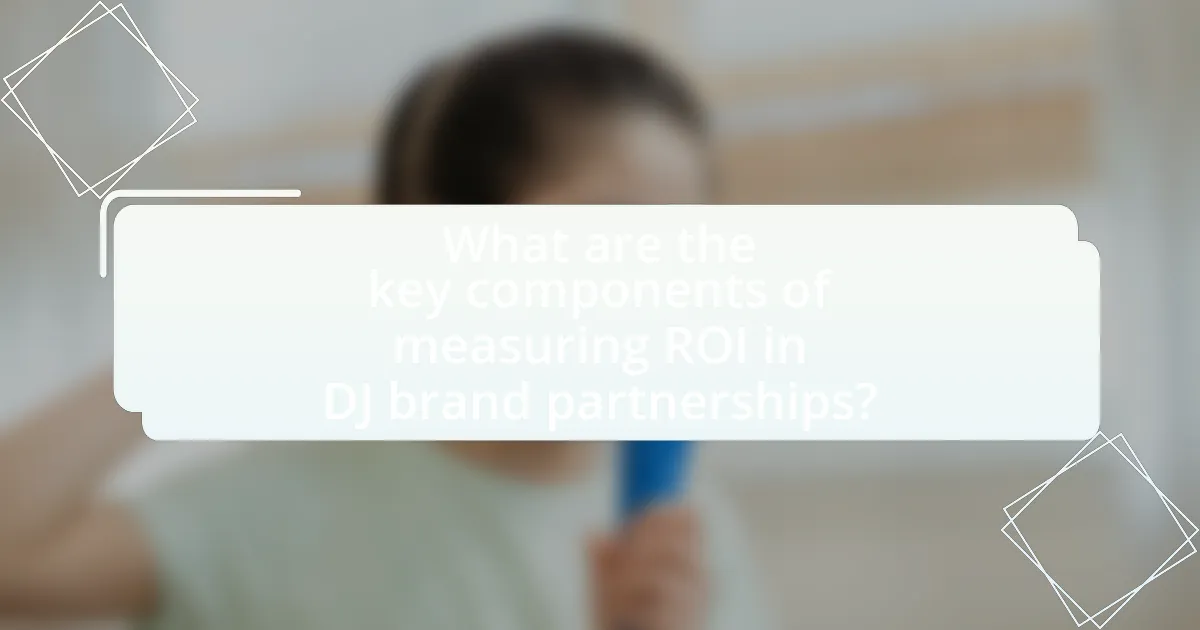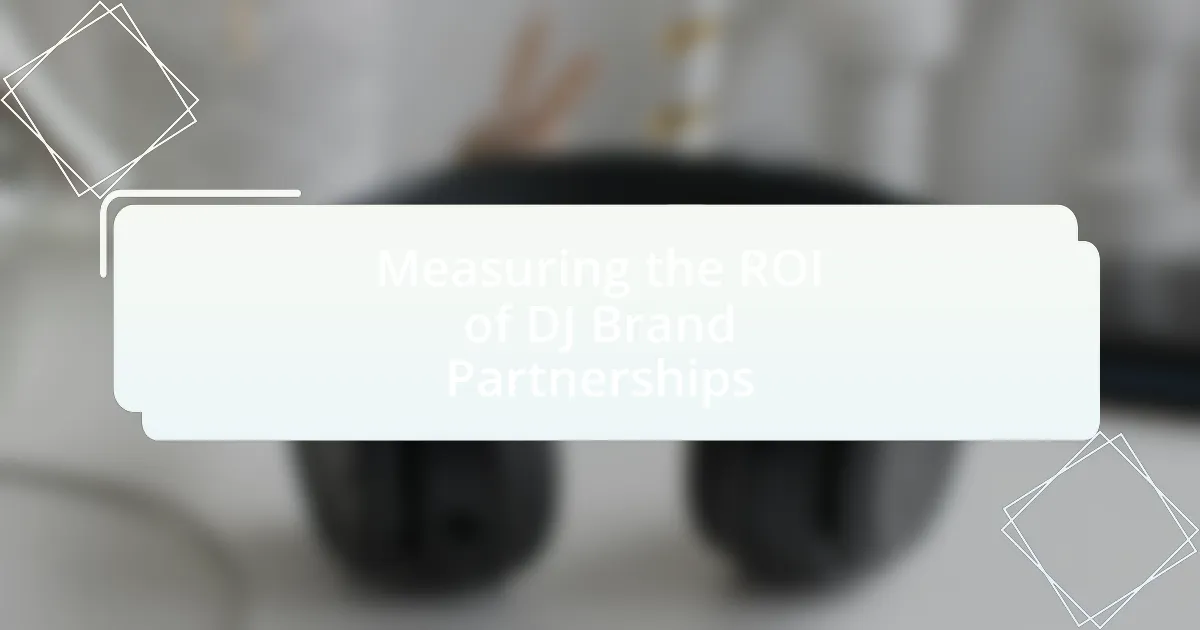Measuring the ROI of DJ brand partnerships involves evaluating the financial returns generated from collaborations between DJs and brands, focusing on metrics such as sales growth, brand awareness, and audience engagement. ROI is defined as the financial return relative to costs incurred, with common metrics including revenue growth and customer acquisition costs. Qualitative factors, such as brand perception and customer loyalty, also play a crucial role in understanding the overall impact of these partnerships. The article outlines the importance of accurate ROI measurement for both DJs and brands, the challenges faced in quantifying returns, and best practices for effective assessment, including the use of technology and data analytics.

What is Measuring the ROI of DJ Brand Partnerships?
Measuring the ROI of DJ brand partnerships involves evaluating the financial return generated from collaborations between DJs and brands. This assessment typically includes analyzing metrics such as increased sales, brand awareness, audience engagement, and social media reach resulting from the partnership. For instance, a study by Nielsen Music found that 70% of consumers are more likely to purchase a product endorsed by a DJ they follow, demonstrating a direct correlation between DJ partnerships and sales growth. By quantifying these outcomes, brands can determine the effectiveness and profitability of their investments in DJ collaborations.
How is ROI defined in the context of DJ brand partnerships?
ROI, or Return on Investment, in the context of DJ brand partnerships is defined as the financial return generated from the partnership relative to the costs incurred. This includes measuring revenue generated from events, merchandise sales, and brand exposure against expenses such as fees paid to the DJ, marketing costs, and production expenses. For instance, if a brand invests $10,000 in a DJ partnership and generates $30,000 in revenue, the ROI would be calculated as ($30,000 – $10,000) / $10,000, resulting in a 200% return. This quantifiable metric allows brands to assess the effectiveness and profitability of their partnerships with DJs.
What metrics are commonly used to measure ROI?
Common metrics used to measure ROI include revenue growth, customer acquisition cost, customer lifetime value, and brand awareness. Revenue growth quantifies the increase in sales attributed to the partnership, while customer acquisition cost assesses the expense incurred to gain new customers through the partnership. Customer lifetime value estimates the total revenue expected from a customer over their relationship with the brand, providing insight into long-term profitability. Brand awareness can be measured through surveys or social media engagement metrics, indicating the partnership’s impact on public recognition. These metrics collectively provide a comprehensive view of the financial and brand-related benefits derived from DJ brand partnerships.
How do qualitative factors influence ROI measurement?
Qualitative factors significantly influence ROI measurement by providing insights into brand perception, customer loyalty, and emotional engagement. These factors, such as brand reputation and customer satisfaction, can enhance or detract from the financial returns of DJ brand partnerships. For instance, a study by the Journal of Marketing Research indicates that positive brand associations can lead to increased customer retention, which ultimately boosts ROI. Therefore, while quantitative metrics like sales figures are essential, qualitative factors offer a deeper understanding of the long-term value generated by partnerships in the DJ industry.
Why is measuring ROI important for DJs and brands?
Measuring ROI is important for DJs and brands because it quantifies the effectiveness of their partnerships and investments. By analyzing ROI, DJs can determine which brand collaborations yield the highest returns, allowing them to make informed decisions about future partnerships. For instance, a study by Nielsen found that brands that effectively measure ROI can increase their marketing effectiveness by up to 30%. This data-driven approach not only enhances financial performance but also strengthens brand alignment and audience engagement, ensuring that both DJs and brands maximize their promotional efforts.
What are the potential benefits of understanding ROI?
Understanding ROI provides critical insights into the effectiveness of investments, enabling businesses to make informed decisions. By analyzing ROI, companies can identify which DJ brand partnerships yield the highest returns, allowing for optimized resource allocation. For instance, a study by the Harvard Business Review found that organizations that effectively measure ROI are 50% more likely to achieve their strategic goals. This understanding also facilitates better negotiation strategies and enhances accountability, as stakeholders can clearly see the financial impact of their partnerships.
How can ROI insights drive future partnership decisions?
ROI insights can drive future partnership decisions by providing data-driven evaluations of past collaborations, enabling brands to identify which partnerships yielded the highest returns. For instance, analyzing metrics such as revenue generated, audience engagement, and brand visibility from previous DJ partnerships allows companies to make informed choices about future collaborations. A study by Nielsen found that brands that leverage ROI data in their partnership strategies see a 20% increase in overall marketing effectiveness. This evidence underscores the importance of using ROI insights to refine partnership strategies, ensuring that future collaborations align with business objectives and maximize profitability.

What are the key components of measuring ROI in DJ brand partnerships?
The key components of measuring ROI in DJ brand partnerships include financial metrics, audience engagement, brand awareness, and long-term value. Financial metrics assess direct revenue generated from the partnership, such as sales attributed to promotional activities. Audience engagement evaluates metrics like social media interactions, event attendance, and streaming numbers, which indicate how well the audience connects with the brand through the DJ. Brand awareness is measured through surveys and brand recall studies, determining the partnership’s impact on consumer perception. Long-term value considers the ongoing relationship benefits, such as customer loyalty and repeat business, which can be quantified over time. These components collectively provide a comprehensive view of the ROI from DJ brand partnerships.
What types of data should be collected for accurate ROI measurement?
To accurately measure ROI, data on revenue generated from partnerships, costs associated with the partnerships, customer engagement metrics, and brand awareness indicators should be collected. Revenue data quantifies the financial return, while cost data provides insight into the investment made. Customer engagement metrics, such as social media interactions and event attendance, reflect the effectiveness of the partnership in reaching the target audience. Brand awareness indicators, including surveys and brand recall studies, help assess the impact of the partnership on brand perception. Collectively, these data types enable a comprehensive evaluation of the ROI from DJ brand partnerships.
How can engagement metrics be quantified?
Engagement metrics can be quantified through various methods, including tracking interactions such as likes, shares, comments, and click-through rates on social media platforms. These metrics provide concrete data on audience participation and interest levels. For instance, a study by HubSpot found that posts with higher engagement rates, such as those receiving more than 100 likes or shares, correlate with increased brand visibility and customer loyalty. Additionally, tools like Google Analytics can measure user behavior on websites, allowing brands to assess engagement through metrics like session duration and bounce rates. This data collectively helps in evaluating the effectiveness of DJ brand partnerships by linking engagement to potential sales and brand awareness.
What financial data is essential for ROI analysis?
The essential financial data for ROI analysis includes total revenue generated from the partnership, total costs associated with the partnership, and the time frame of the investment. Total revenue reflects the income directly attributable to the DJ brand partnership, while total costs encompass all expenses incurred, such as marketing, production, and operational costs. The time frame is crucial as it helps in calculating the ROI percentage over a specific period, allowing for a clear assessment of profitability. Accurate ROI analysis relies on these data points to determine the effectiveness and financial viability of the partnership.
How do different partnership models affect ROI measurement?
Different partnership models significantly influence ROI measurement by altering the metrics and methods used to evaluate success. For instance, a revenue-sharing model directly ties financial outcomes to partnership performance, allowing for straightforward ROI calculations based on sales generated from the collaboration. In contrast, a sponsorship model may focus on brand exposure and engagement metrics, requiring a more complex evaluation of intangible benefits, such as audience reach and brand sentiment, which can complicate ROI measurement. Research indicates that partnerships with clear financial incentives tend to yield more quantifiable ROI, while those emphasizing brand alignment and audience engagement often necessitate qualitative assessments, making direct comparisons challenging.
What are the distinctions between sponsorships and collaborations?
Sponsorships and collaborations differ primarily in their structure and objectives. Sponsorships involve a financial or resource-based support from a brand to an individual or event, typically in exchange for promotional benefits, such as brand visibility. For instance, a brand may sponsor a DJ event, providing funds in return for logo placement and advertising opportunities. In contrast, collaborations are partnerships where two or more parties work together towards a common goal, often sharing resources, ideas, and responsibilities, such as a DJ and a brand co-creating a music track or event. This distinction highlights that sponsorships focus on financial support for promotional gain, while collaborations emphasize joint efforts and shared creative outcomes.
How does the duration of a partnership impact ROI calculations?
The duration of a partnership significantly impacts ROI calculations by influencing the time frame over which costs and benefits are assessed. Longer partnerships typically allow for the accumulation of more data, leading to a more accurate assessment of returns, as benefits may not be immediately realized. For instance, a study by the Harvard Business Review indicates that partnerships that last over three years tend to yield higher ROI due to the establishment of trust and deeper collaboration, which can enhance brand loyalty and customer engagement. Conversely, shorter partnerships may not provide enough time to fully realize the potential benefits, resulting in skewed ROI figures that do not reflect the true value of the partnership.

What challenges exist in measuring the ROI of DJ brand partnerships?
Measuring the ROI of DJ brand partnerships presents several challenges, primarily due to the difficulty in quantifying intangible benefits. One major challenge is the lack of standardized metrics to evaluate success, as brand awareness and audience engagement are often subjective and vary widely across different campaigns. Additionally, the impact of a DJ’s influence on sales or brand perception can be indirect and delayed, making it hard to attribute specific financial outcomes directly to the partnership. Furthermore, the dynamic nature of the music industry and changing consumer behaviors complicate the analysis, as external factors can significantly influence results. These complexities highlight the need for more robust methodologies and tools to accurately assess the effectiveness of DJ brand partnerships.
What common pitfalls should be avoided in ROI measurement?
Common pitfalls to avoid in ROI measurement include failing to define clear objectives, neglecting to account for all relevant costs, and using inappropriate metrics. Defining clear objectives is crucial because it establishes the framework for measurement; without specific goals, the ROI calculation can become ambiguous and misleading. Neglecting to account for all relevant costs, such as hidden expenses or opportunity costs, can result in an inflated ROI figure that does not accurately reflect the true financial impact. Additionally, using inappropriate metrics, such as focusing solely on short-term gains instead of long-term value, can skew the analysis and lead to poor decision-making. These pitfalls can significantly undermine the effectiveness of ROI measurement in evaluating DJ brand partnerships.
How can subjective interpretations skew ROI results?
Subjective interpretations can skew ROI results by introducing bias in the evaluation of performance metrics. When individuals assess the success of DJ brand partnerships, personal opinions and experiences can lead to inconsistent measurements of outcomes, such as engagement or sales. For instance, if a DJ perceives a partnership as successful based on personal enjoyment rather than quantifiable metrics, this can inflate perceived ROI. Research indicates that subjective assessments can vary significantly among stakeholders, leading to discrepancies in reported ROI figures. A study by the Harvard Business Review found that subjective evaluations can result in a 20-30% variance in performance assessments, highlighting the impact of personal bias on financial metrics.
What role does market variability play in ROI assessment?
Market variability significantly influences ROI assessment by affecting the predictability of returns on investments. Fluctuations in market conditions, such as changes in consumer preferences or economic factors, can lead to varying levels of engagement and revenue generation from DJ brand partnerships. For instance, a study by McKinsey & Company found that brands that adapt their strategies to market variability can achieve up to 30% higher ROI compared to those that do not. This demonstrates that understanding and responding to market variability is crucial for accurately assessing the effectiveness and profitability of brand partnerships in the DJ industry.
How can technology aid in measuring ROI effectively?
Technology aids in measuring ROI effectively by providing advanced analytics tools that track performance metrics in real-time. These tools, such as customer relationship management (CRM) systems and marketing automation platforms, enable brands to gather data on consumer engagement, sales conversions, and campaign effectiveness. For instance, a study by HubSpot found that companies using marketing automation see a 451% increase in qualified leads, demonstrating the direct correlation between technology use and improved ROI measurement. Additionally, data visualization software allows brands to interpret complex data sets easily, facilitating informed decision-making and strategic adjustments to enhance partnership outcomes.
What tools are available for tracking and analyzing ROI?
Tools available for tracking and analyzing ROI include Google Analytics, HubSpot, and Tableau. Google Analytics provides insights into website traffic and user behavior, allowing businesses to measure the effectiveness of their marketing campaigns. HubSpot offers comprehensive marketing automation features that track customer interactions and conversions, enabling detailed ROI analysis. Tableau is a powerful data visualization tool that helps organizations analyze complex data sets, making it easier to interpret ROI metrics. These tools are widely used in the industry and are supported by extensive documentation and user communities, ensuring their reliability and effectiveness in measuring ROI.
How can data analytics enhance ROI insights?
Data analytics enhances ROI insights by providing precise measurements of campaign performance and consumer behavior. By analyzing data from various sources, such as social media engagement, sales figures, and customer feedback, organizations can identify which DJ brand partnerships yield the highest returns. For instance, a study by McKinsey & Company found that companies leveraging data analytics can improve their marketing ROI by 15-20%. This quantifiable evidence demonstrates that data-driven decisions lead to more effective strategies, optimizing resource allocation and maximizing profitability in DJ brand partnerships.
What best practices should be followed for accurate ROI measurement?
To achieve accurate ROI measurement for DJ brand partnerships, it is essential to establish clear objectives and metrics before the partnership begins. Defining specific goals, such as increased brand awareness or sales growth, allows for targeted measurement. Additionally, utilizing both quantitative and qualitative data enhances the analysis; for instance, tracking sales figures alongside social media engagement metrics provides a comprehensive view of impact.
Furthermore, employing a consistent methodology for data collection and analysis ensures reliability. For example, using tools like Google Analytics for web traffic and sales tracking can yield precise insights. Regularly reviewing and adjusting the measurement strategy based on initial findings also contributes to accuracy, as it allows for real-time optimization of the partnership’s effectiveness.
These practices are supported by industry standards, such as the Marketing Accountability Standards Board, which emphasizes the importance of clear objectives and consistent measurement frameworks in ROI assessments.
How often should ROI be evaluated in DJ brand partnerships?
ROI in DJ brand partnerships should be evaluated at least quarterly. This frequency allows for timely adjustments to strategies based on performance metrics, ensuring that both the DJ and the brand can optimize their collaboration. Regular evaluations can reveal trends and insights that inform future decisions, enhancing the overall effectiveness of the partnership. According to industry standards, quarterly assessments align with typical marketing review cycles, enabling stakeholders to respond swiftly to market changes and audience engagement levels.
What strategies can improve the accuracy of ROI assessments?
To improve the accuracy of ROI assessments, organizations should implement data-driven methodologies, such as utilizing advanced analytics and performance metrics. These methodologies allow for precise tracking of financial outcomes against marketing investments, ensuring that all relevant data points are considered. For instance, employing tools like customer relationship management (CRM) systems can provide insights into customer engagement and conversion rates, which are critical for calculating ROI accurately. Additionally, conducting regular market research can help in understanding consumer behavior and preferences, further refining the assessment process. By integrating these strategies, organizations can achieve a more reliable and comprehensive evaluation of their ROI from DJ brand partnerships.

Leave a Reply